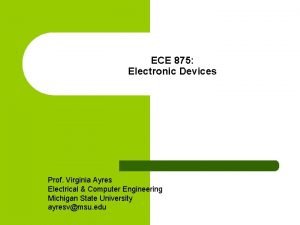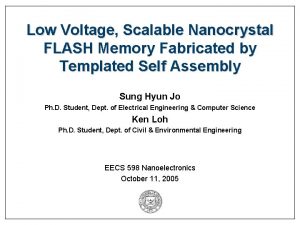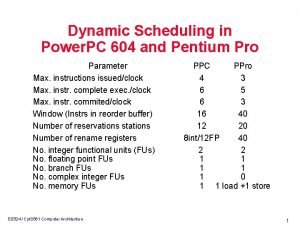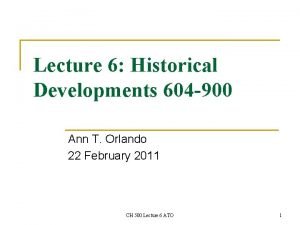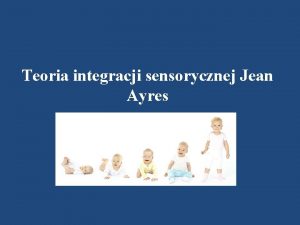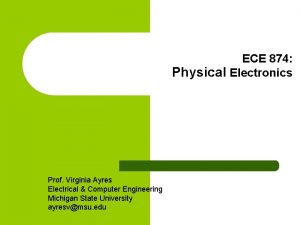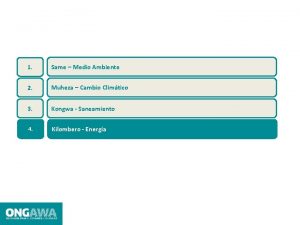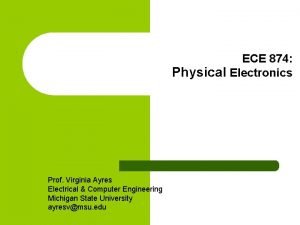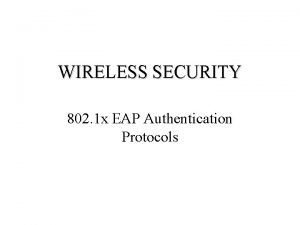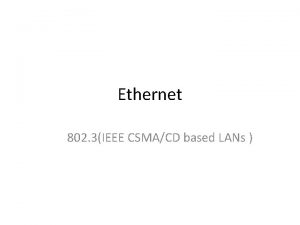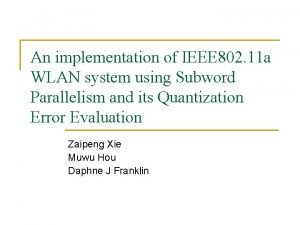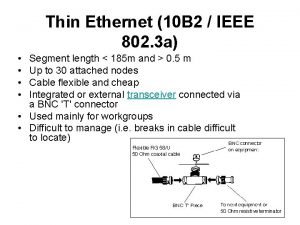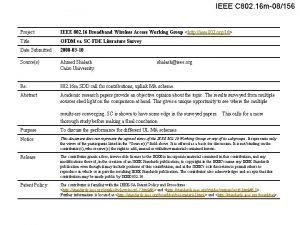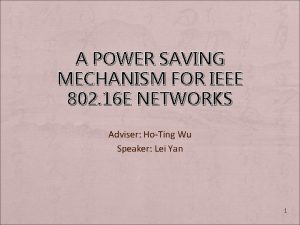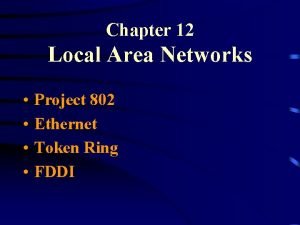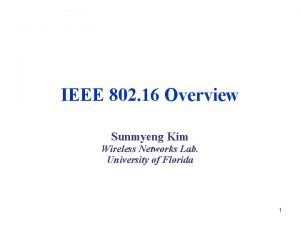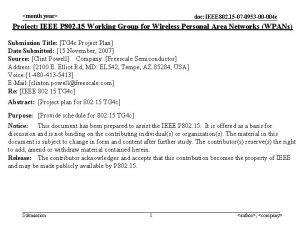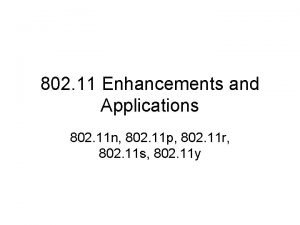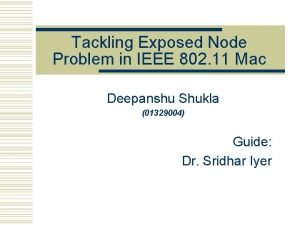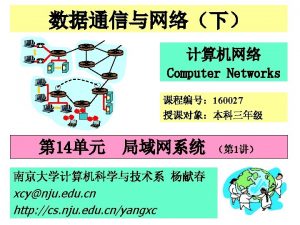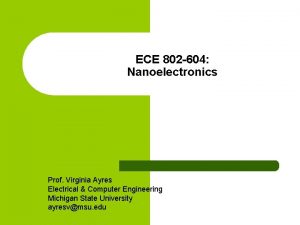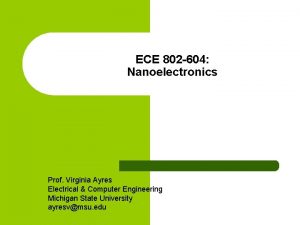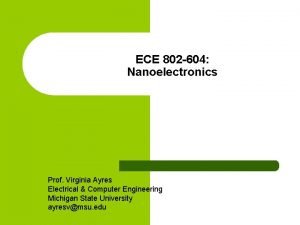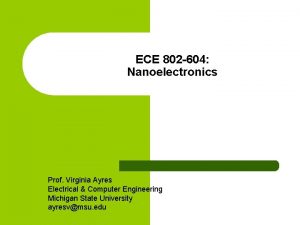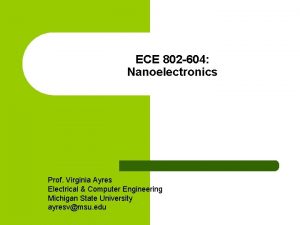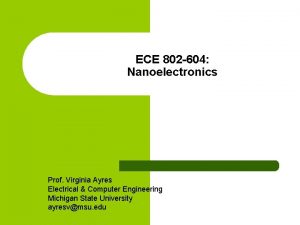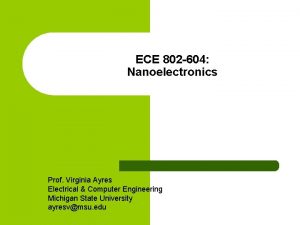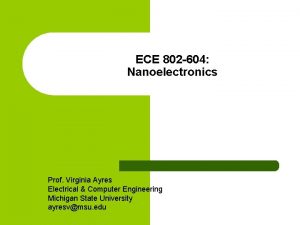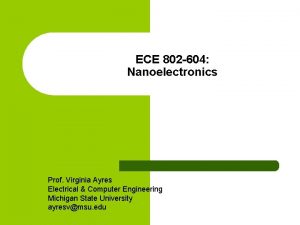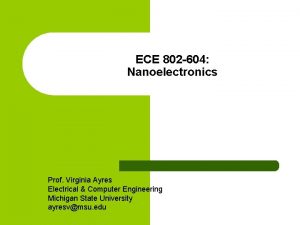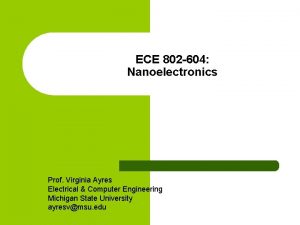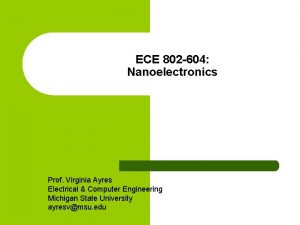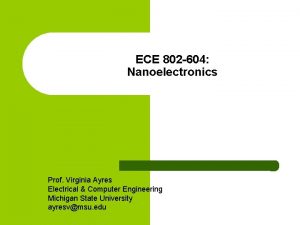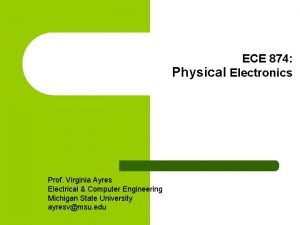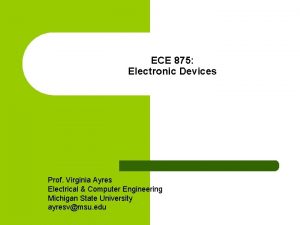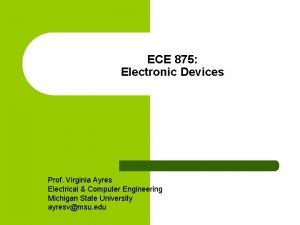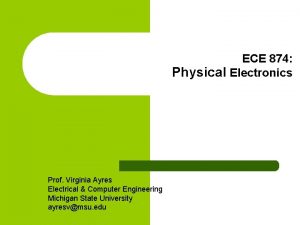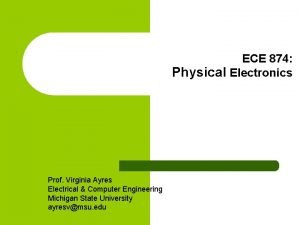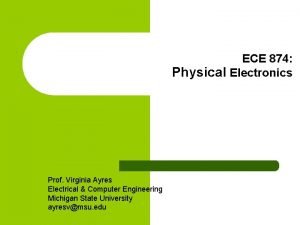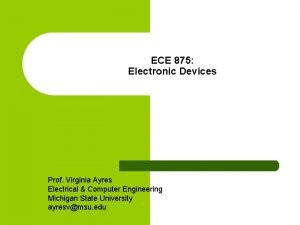ECE 802 604 Nanoelectronics Prof Virginia Ayres Electrical

































![2 -DEG density of states + B-field: d[E – (ES + En)] 2 nd: 2 -DEG density of states + B-field: d[E – (ES + En)] 2 nd:](https://slidetodoc.com/presentation_image_h2/7e9dac79ec204f6abce8328cf49f6313/image-34.jpg)



- Slides: 37

ECE 802 -604: Nanoelectronics Prof. Virginia Ayres Electrical & Computer Engineering Michigan State University ayresv@msu. edu

Lecture 06, 17 Sep 13 In Chapter 01 in Datta: Two dimensional electron gas (2 -DEG) DEG goes down, mobility goes up Define mobility Proportional to momentum relaxation time tm Count carriers n. S available for current – Pr. 1. 3 (1 -DEG) How n. S influences scattering in unexpected ways – Pr 1. 1 (2 -DEG) One dimensional electron gas (1 -DEG) Special Schrödinger eqn (Con E) that accommodates: Electronic confinement: band bending due to space charge Useful external B-field Experimental measure for mobility Examples VM Ayres, ECE 802 -604, F 13

Lec 05: Example: write down the wave function for a 1 -DEG VM Ayres, ECE 802 -604, F 13

Lec 05: Example: write down the energy eigenvalues for a 1 DEG assuming an infinite square well potential in the quantized directions VM Ayres, ECE 802 -604, F 13

Example: draw a diagram of this 1 -DEG kz ky W t kx z Width W in y y Thickness t in z x VM Ayres, ECE 802 -604, F 13

Example: write down the energy eigenvalues for a 1 -DEG assuming an infinite square well potential in the quantized directions. Assume nz = 1 st and Ly W VM Ayres, ECE 802 -604, F 13

Example: write down the energy eigenvalues for a 1 -DEG assuming an infinite square well potential in the quantized directions. Assume nz = 1 st and Ly W Answer: VM Ayres, ECE 802 -604, F 13

Example: find the number of energy levels NT(E) for a 1 -DEG assuming an infinite square well potential in the quantized directions VM Ayres, ECE 802 -604, F 13

Example: Generally what is the relation of the N(E) to NT(E)? Write this down for both a 2 -DEG and a 1 -DEG. VM Ayres, ECE 802 -604, F 13

Answer: VM Ayres, ECE 802 -604, F 13

Example: Generally what is the relation of concentration ns to N(E)? VM Ayres, ECE 802 -604, F 13

Example: Generally what is the relation of concentration n to N(E)? Answer: n= N(E)n-DEG f 0(E) d. E Key for correct nanotechnology VM Ayres, ECE 802 -604, F 13

Example: How do you define “hot” versus “cold” for the Fermi probability f 0(E)? VM Ayres, ECE 802 -604, F 13

Answer: The definitions are what the denominator is doing: Hot: Cold: You can’t meet the Cold condition by any change in T. The only way to do it is with Ef > E: Cold means the semiconductor is degenerate. VM Ayres, ECE 802 -604, F 13

VM Ayres, ECE 802 -604, F 13

Hint: Plot n versus (Ef – ES )/ E 1 not versus Ef VM Ayres, ECE 802 -604, F 13

Parabolic potential is new. Why interesting: this is the single electron transistor (SET) Kastner article, MIT VM Ayres, ECE 802 -604, F 13

2 -DEG: Before: U(x, y) = 0 and A = 0: no E or B Now: U(x, y) = U(y) = ½ mw 02 y 2. Still have A = 0: no E or B but let’s get ready for B anyway VM Ayres, ECE 802 -604, F 13

U(x, y) = U(y), and B is possible: z B y x IDS e- Like Hall effect: expect: the x motion is disturbed by the B-field VM Ayres, ECE 802 -604, F 13

2 -DEG -> 1 -DEG: x x Now put in: B=0 U(y) = ½ mw 02 y 2 VM Ayres, ECE 802 -604, F 13

x Wavefunction: VM Ayres, ECE 802 -604, F 13

Energy eigenvalues are: USE this in your HW VM Ayres, ECE 802 -604, F 13

Now find N(E) Now find n. L VM Ayres, ECE 802 -604, F 13

Useful B-field: experimental measures: In real life, electron densities and mobilities do not come printed on nanowires, nanotubes or graphene sheets! VM Ayres, ECE 802 -604, F 13

Useful B-field: experimental measures: What happens when you run a Hall effect measurement in a 2 DEG? Measurement set-up: VM Ayres, ECE 802 -604, F 13

Expectation: Drude model: wrong: 2 -DEG: VM Ayres, ECE 802 -604, F 13

Expectation: Drude model: wrong: Write in terms of something you can measure: J: VM Ayres, ECE 802 -604, F 13

Expectation: Drude model: wrong: Dig out your resistivities and then do V = IR VM Ayres, ECE 802 -604, F 13

Expectation: Drude model: wrong: VHall Vx Dotted lines are fictitious VM Ayres, ECE 802 -604, F 13

Expectation: Drude model: wrong: Any low-field place where the measurement is actually doing this, life is good. VM Ayres, ECE 802 -604, F 13

Any low-field place where the measurement is actually doing this, life is good. VM Ayres, ECE 802 -604, F 13

What happens as you increase B: VHall develops a staircase Vx develops oscillations VM Ayres, ECE 802 -604, F 13

What happens when you run a Hall effect measurement in a 2 DEG? Stated without proof: The density of states used to be a constant: Now it’s a bunch (n + ½) of spikes (delta function). Each n = 0, 1, … is called a Landau level. VM Ayres, ECE 802 -604, F 13
![2 DEG density of states Bfield dE ES En 2 nd 2 -DEG density of states + B-field: d[E – (ES + En)] 2 nd:](https://slidetodoc.com/presentation_image_h2/7e9dac79ec204f6abce8328cf49f6313/image-34.jpg)
2 -DEG density of states + B-field: d[E – (ES + En)] 2 nd: n = 1 1 st: n = 0 VM Ayres, ECE 802 -604, F 13

Spikes in N(E) => spikes in n. S => spikes/troughs in current Which can be interpreted as an oscillation in resistivity. Resistivities are proportional to the measured voltages VM Ayres, ECE 802 -604, F 13

High B-field measurement of carrier density: number of occupied Landau levels Changes by 1 between any two levels VM Ayres, ECE 802 -604, F 13

VM Ayres, ECE 802 -604, F 13
 Virginia ayres
Virginia ayres Virginia ayres
Virginia ayres Bridges from 802.x to 802.y
Bridges from 802.x to 802.y Bridges from 802.x to 802.y
Bridges from 802.x to 802.y Semiconductor works as insulator at 0ºc
Semiconductor works as insulator at 0ºc Measuring device
Measuring device Nanoelectronics
Nanoelectronics Power pc 604
Power pc 604 Safari 604
Safari 604 The ruler of the land 604
The ruler of the land 604 Jean ayres
Jean ayres Ayres
Ayres Rusty and the ayres rockettes band members
Rusty and the ayres rockettes band members Jean ayres
Jean ayres Ayres locales
Ayres locales Natasha ayres
Natasha ayres Purandare's dilator
Purandare's dilator Ayres
Ayres Northern virginia seo audit
Northern virginia seo audit 802 eap
802 eap Ethernet 802
Ethernet 802 Wlan 802
Wlan 802 802-3-ethernet
802-3-ethernet Nn dfe
Nn dfe 802 16
802 16 Project 802
Project 802 802 ieee
802 ieee Modulation coding scheme
Modulation coding scheme Modelo ieee 802
Modelo ieee 802 802 15
802 15 Arquitetura ieee 802
Arquitetura ieee 802 Wlan standards
Wlan standards 507-802-380
507-802-380 Ccna 640-802
Ccna 640-802 Geo 802
Geo 802 802 11 n
802 11 n Exposed node problem
Exposed node problem 802 protocols
802 protocols
